247 scholarly books by University Press of New England and 14
start with A
247 scholarly books by University Press of New England and 14
247 scholarly books by University Press of New England
14 start with A start with A
14 start with A start with A

Air Officer Commanding
Hugh Dowding, Architect of the Battle of Britain
John T. LaSaine
University Press of New England, 2018
Hugh Dowding may be described as the prime architect of British victory in the battle of Britain, and thus as one of a handful of officers and men most responsible for ensuring that Hitler’s planned invasion of England never occurred. Dowding was born in 1882 at the apex of British imperial power and had an early career as a gunner on the fabled North-West Frontier of the British Indian Empire. During the first year of World War I, he served with distinction as a combat pilot in France, but his real test would come in 1936, when he was assigned the critical task of reorganizing the Air Defense of Great Britain as the first air officer commanding-in-chief of the new RAF Fighter Command. In that capacity he stood up to senior staff—and Winston Churchill—by preventing the dismantling of British air defenses during the Battle of France in the spring of 1940, defying pressure from the British Army, Britain’s French allies, and His Majesty’s Government to send the bulk of the RAF’s front-line fighters to the Continent in what Dowding predicted would be a futile effort to stem the German onslaught. While holding back as many of his best fighter aircraft as he could, in June Dowding deployed 11 Group under his hand-picked lieutenant, Air Vice-Marshal Keith Park, to repulse the Luftwaffe over Dunkirk, covering the evacuation of some 338,000 British and French troops from the Continent. During the three months of fighting known as the Battle of Britain, the integrated air defense system organized and trained by Dowding fought the vaunted Luftwaffe to a standstill in daylight air-to-air combat. In October, the Germans abandoned their attempt to win a decisive battle for air superiority over England, turning instead to the protracted campaign of attrition by nighttime area bombing known as the Blitz. In building, defending, and overseeing the operations of Fighter Command, Dowding was thus not only one of the master builders of air power, but also the only airman to have been the winning commander in one of history’s decisive battles.
[more]

Al Qaeda Declares War
The African Embassy Bombings and America’s Search for Justice
Tod Hoffman
University Press of New England, 2014
Three years before the events of 9/11, Osama bin Laden sent al Qaeda suicide bombers on a coordinated attack to destroy the U.S. embassies in Nairobi, Kenya, and Dar es Salaam, Tanzania. That day, August 7, 1998, more than two hundred people were killed and thousands were wounded. Responding immediately, the FBI launched the largest international investigation in its history. Within months, suspects were arrested in six countries. The U.S. Attorney for the Southern District of New York indicted twenty-two individuals, including the elusive bin Laden. In February 2001 a landmark trial of four of the accused was held in Manhattan in the shadow of the World Trade Center. Al Qaeda Declares War: The African Embassy Bombings and America’s Search for Justice explores the step-by-step procedures the United States employed in analyzing these attacks, identifying the suspects, tracking down and apprehending them, building a case, and prosecuting them. It is this case that established the legal basis for hunting down bin Laden, and the trial makes for a gripping courtroom drama, in which the robust principles of American justice confront the fanaticism of true believers. Tod Hoffman argues forcefully that the process after the 1998 incident stands in marked contrast to the illegal detention, torture, and abrogation of rights that followed 9/11. Indeed, reverberations from the African embassy bombings continue in the ongoing hunt for perpetrators still at large, and in targeted killings by drones. Al Qaeda Declares War dramatically recounts the terror and bloodshed of that day in Africa and shows that America’s search for justice afterward offers important lessons for today.
[more]
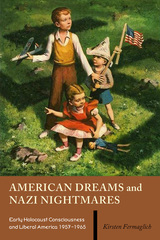
American Dreams and Nazi Nightmares
Early Holocaust Consciousness and Liberal America, 1957-1965
Kirsten Fermaglich
University Press of New England, 2007
To a great extent, Holocaust consciousness in the contemporary United States has become intertwined with American Jewish identity and with support for right-wing Israeli politics -- but this was not always the case. In this illuminating study, Kirsten Fermaglich demonstrates that in the late 1950s and early 1960s, many American Jewish writers and academics viewed the Nazi extermination of European Jewry as a subject of universal interest, with important lessons to be learned for the liberal reform of American politics. Fermaglich analyzes the lives and writings of Stanley M. Elkins, Betty Friedan, Stanley Milgram, and Robert Jay Lifton, four social scientific thinkers whose work was shaped by a liberal perspective. For them, the Holocaust served as a critical frame of reference for a particular issue: Elkins on slavery's legacy, Friedan on the oppressions of domesticity, Milgram on the willingness to obey, and Lifton on war's survivors. In each case, these thinkers were deeply influenced by their Jewish backgrounds, whether by early encounters with antisemitism or by the profound sense that only fate and an ocean had spared them death in Hitler's Europe. Thus, each chose imagery from the concentration camps, albeit utterly devoid of a particular Jewish association, to illuminate themes that advanced liberal politics, including civil rights, the nuclear test ban, feminism, and Vietnam veterans' rights. Rather than being offended by these authors' comparisons between American institutions and Nazi concentration camps, American audiences of all ethnic and religious backgrounds during the late 1950s and early 1960s generally cheered these authors' Nazi imagery and adopted it as part of their own political ideology. Fermaglich demonstrates that liberalism in the United States in the 1960s was more substantially shaped by the Holocaust than we have previously recognized.
[more]
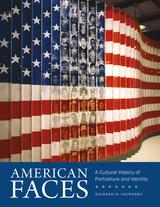
American Faces
A Cultural History of Portraiture and Identity
Richard H. Saunders
University Press of New England, 2016
Portraits. We know what they are, but why do we make them? Americans have been celebrating themselves in portraits since the arrival of the first itinerant portrait painters to the colonies. They created images to commemorate loved ones, glorify the famous, establish our national myths, and honor our shared heroes. Whether painting in oil, carving in stone, casting in bronze, capturing on film, or calculating in binary code, we spend considerable time creating, contemplating, and collecting our likenesses. In this sumptuously illustrated book, Richard H. Saunders explores our collective understanding of portraiture, its history in America, how it shapes our individual and national identity, and why we make portraits—whether for propaganda and public influence or for personal and private appreciation. American Faces is a rich and fascinating view of ourselves.
[more]
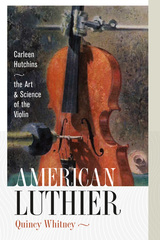
American Luthier
Carleen Hutchins—the Art and Science of the Violin
Quincy Whitney
University Press of New England, 2016
From the time of Stradivari, the mysterious craft of violinmaking has been a closely guarded, lucrative, and entirely masculine preserve. In the 1950s Carleen Maley Hutchins was a grade school science teacher, amateur trumpet player, and New Jersey housewife. When musical friends asked her to trade a trumpet for a $75 viola, she decided to try making one, thus setting in motion a surprising career. A self-taught genius who went head to head with a closed and ancient guild, Hutchins carved nearly 500 stringed instruments over the course of half a century and collaborated on more than 100 experiments in violin acoustics. In answer to a challenge from a composer, she built the first violin octet—a family of eight violins ranging in size from an eleven-inch treble to a seven-foot contrabass, and in register across the gamut of the piano keyboard. She wrote more than 100 technical papers—including two benchmark Scientific American cover articles—founded an international society devoted to violin acoustics, and became the only American and the only woman to be honored in Cremona, Italy, the birthplace of Stradivari. Hutchins died in 2009 at the age of ninety-eight. The most innovative violinmaker of the modern age, she set out to explore two worlds she knew virtually nothing about—violins and acoustical physics. American Luthier chronicles the life of this unsung woman who altered everything in a world that had changed little in three centuries.
[more]
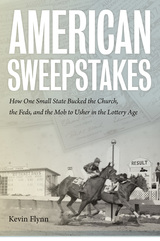
American Sweepstakes
How One Small State Bucked the Church, the Feds, and the Mob to Usher in the Lottery Age
Kevin Flynn
University Press of New England, 2015
By 1963 public lotteries—a time-honored if tarnished method of raising revenue for everything from the Roman roads to Washington’s Continental Army—had been outlawed in the United States for seventy years. The only legal gambling in America was found in Nevada, where mob involvement had at first been an open secret, and then revealed as no secret at all. In New Hampshire—a conservative, rural state with no sales tax and persistent problems with funding education—state legislator Larry Pickett had filed a bill to establish a lottery in every legislative session since 1953. To the surprise of many, it won passage a decade later and was signed into law by John King, the state’s first Democratic governor in forty years. American Sweepstakes describes how King assembled an unlikely group of supporters—including a celebrated FBI agent and the staunchly conservative publisher of the state’s leading newspaper—to establish the first state lottery in the nation, paving the way for what is today a $78 billion enterprise. Despite the remonstrations of the Catholic Church, the threat of arrest by the federal government, the strident denunciations of nearly every newspaper editorialist in the country, and the very real fear that the lottery would be co-opted by the mob, eleven thoroughbred racehorses leapt from the gate on September 12, 1964, in the first New Hampshire Sweepstakes, ushering in the lottery age in America.
[more]

America's Founding Fruit
The Cranberry in a New Environment
Susan Playfair
University Press of New England, 2014
The cranberry, Vaccinium macrocarpon, is one of only three cultivated fruits native to North America. The story of this perennial vine began as the glaciers retreated about fifteen thousand years ago. Centuries later, it kept Native Americans and Pilgrims alive through the winter months, played a role in a diplomatic gesture to King Charles in 1677, protected sailors on board whaling ships from scurvy, fed General Grant’s men in 1864, and provided over a million pounds of sustenance per year to our World War II doughboys. Today, it is a powerful tool in the fight against various forms of cancer. This is America’s superfruit. This book poses the question of how the cranberry, and by inference other fruits, will fare in a warming climate. In her attempt to evaluate the effects of climate change, Susan Playfair interviewed growers from Massachusetts west to Oregon and from New Jersey north to Wisconsin, the cranberry’s temperature tolerance range. She also spoke with scientists studying the health benefits of cranberries, plant geneticists mapping the cranberry genome, a plant biologist who provided her with the first regression analysis of cranberry flowering times, and a migrant beekeeper trying to figure out why the bees are dying. Taking a broader view than the other books on cranberries, America’s Founding Fruit presents a brief history of cranberry cultivation and its role in our national history, leads the reader through the entire cultivation process from planting through distribution, and assesses the possible effects of climate change on the cranberry and other plants and animals. Could the American cranberry cease growing in the United States? If so, what would be lost?
[more]

The Amish Struggle with Modernity
Edited by Donald B. Kraybill and Marc A. Olshan
University Press of New England, 1994
Throughout their history, the Amish communities of North America have tried to remain separate from the currents of progress that swirl in the larger society. The authors and others argue that although the nation’s nearly 140,000 Amish continue to resist the influence of worldly institutions, the communities have nonetheless acquiesced to modernity in significant ways. Such change has not been easy and The Amish Struggle with Modernity examines on a national scale dilemmas that arise when a people devoted to plain living face the complexities of modern life.
[more]

Angela Gheorghiu
A Life for Art
Angela Gheorghiu
University Press of New England, 2018
Angela Gheorghiu is one of the most passionate and talented artists working in opera today, a larger-than-life figure whose intensity and drive, on stage and off, have commanded the attention of the opera world. Largely composed of exclusive interviews with the artist, this authorized biography of the internationally acclaimed soprano, covers Gheorghiu’s life and career from her childhood in Communist Romania to her spectacular Covent Garden debut in 1992 and up to the present day. In it, Gheorghiu shares new insights into the performance of many of her iconic stage roles and her collaborations with opera’s leading lights. Also featured are commentaries and reminiscences by such celebrated figures in the music and art worlds as Grace Bumbry, José Carreras, Plácido Domingo, Marilyn Horne, Bryn Terfel, and Franco Zeffirelli.
[more]
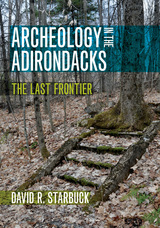
Archeology in the Adirondacks
The Last Frontier
David R. Starbuck
University Press of New England, 2018
While numerous books have been written about the great camps, hiking trails, and wildlife of the Adirondacks, noted anthropologist David R. Starbuck offers the only archeological guide to a region long overlooked by archeologists who thought that “all the best sites” were elsewhere. This beautifully illustrated volume focuses on the rich and varied material culture brought to the mountains by their original Native American inhabitants, along with subsequent settlements created by soldiers, farmers, industrialists, workers, and tourists. Starbuck examines Native American sites on Lake George and Long Lake; military and underwater sites throughout the Lake George, Fort Ticonderoga, and Crown Point regions; old industrial sites where forges, tanneries, and mines once thrived; farms and the rural landscape; and many other sites, including the abandoned Frontier Town theme park, the ghost town of Adirondac, Civilian Conservation Corps camps, ski areas, and graveyards.
[more]

Archyology
The Long Lost Tales of Archy and Mehitabel
Don Marquis
University Press of New England, 2009
America’s beloved archy and mehitabel finally return in these entrancing uncollected stories.
[more]
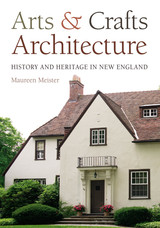
Arts and Crafts Architecture
History and Heritage in New England
Maureen Meister
University Press of New England, 2014
This book offers the first full-scale examination of the architecture associated with the Arts and Crafts movement that spread throughout New England at the turn of the twentieth century. Although interest in the Arts and Crafts movement has grown since the 1970s, the literature on New England has focused on craft production. Meister traces the history of the movement from its origins in mid-nineteenth-century England to its arrival in the United States and describes how Boston architects including H. H. Richardson embraced its tenets in the 1870s and 1880s. She then turns to the next generation of designers, examining buildings by twelve of the region’s most prominent architects, eleven men and a woman, who assumed leadership roles in the Society of Arts and Crafts, founded in Boston in 1897. Among them are Ralph Adams Cram, Lois Lilley Howe, Charles Maginnis, and H. Langford Warren. They promoted designs based on historical precedent and the region’s heritage while encouraging well-executed ornament. Meister also discusses revered cultural personalities who influenced the architects, notably Ralph Waldo Emerson and art historian Charles Eliot Norton, as well as contemporaries who shared their concerns, such as Louis Brandeis. Conservative though the architects were in the styles they favored, they also were forward-looking, blending Arts and Crafts values with Progressive Era idealism. Open to new materials and building types, they made lasting contributions, with many of their designs now landmarks honored in cities and towns across New England.
[more]
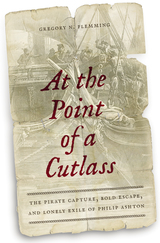
At the Point of a Cutlass
The Pirate Capture, Bold Escape, and Lonely Exile of Philip Ashton
Gregory N. Flemming
University Press of New England, 2015
A handful of sea stories define the American maritime narrative. Stories of whaling, fishing, exploration, naval adventure, and piracy have always captured our imaginations, and the most colorful of these are the tales of piracy. Called America’s real-life Robinson Crusoe, the true story of Philip Ashton—a nineteen-year-old fisherman captured by pirates, impressed as a crewman, subjected to torture and hardship, who eventually escaped and lived as a castaway and scavenger on a deserted island in the Caribbean—was at one time as well known as the tales of Cooper, Hawthorne, and Defoe. Based on a rare copy of Ashton’s 1725 account, Gregory N. Flemming’s vivid portrait recounts this maritime world during the golden age of piracy. Fishing vessels and merchantmen plied the coastal waters and crisscrossed the Atlantic and Caribbean. It was a hard, dangerous life, made more so by both the depredations and temptations of piracy. Chased by the British Royal Navy, blown out of the water or summarily hung when caught, pirate captains such as Edward Low kidnapped, cajoled, beat, and bribed men like Ashton into the rich—but also vile, brutal, and often short—life of the pirate. In the tradition of Nathaniel Philbrick, At the Point of a Cutlass expands on a lost classic narrative of America and the sea, and brings to life a forgotten world of ships and men on both sides of maritime law.
[more]
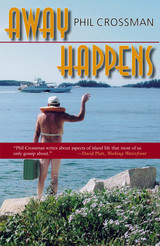
Away Happens
Phil Crossman
University Press of New England, 2005
“Several years ago it was revealed to me that creative nonfiction was a legitimate literary genre,” writes Phil Crossman. “It was the most liberating experience of my life. All these years I thought I’d been simply lying.” Crossman is a humorist in the Mark Twain mold: wry, satiric, and keenly aware of the shortcomings of human beings, but with a leavening of self-deprecation and underlying sympathy. Though rooted in a regional consciousness (coastal Maine), his humor succeeds in making the local universal. Away Happens considers daily life on an island in Penobscot Bay that supports both a tight-knit local community and a larger seasonal population. Whether he is recounting a debate that happened at the Lions Club over who counts as a “local” or describing his adventures getting the Thanksgiving turkey into the oven, ruminating on how the ferry schedule shapes island life or recalling a local crime spree, Crossman is funny, unsentimental, and authentically Maine. “There are only two places, Here, this island off the coast of Maine, and Away. Here, this place, is a small place and Away, everywhere else, is a big place, but make no mistake about it, Here is Here and Away is not. 1276 people live Here. Billions more live Away than live Here, although increasingly, during the summer, it seems otherwise.” —From the Book
[more]
READERS
Browse our collection.
PUBLISHERS
See BiblioVault's publisher services.
STUDENT SERVICES
Files for college accessibility offices.
UChicago Accessibility Resources
home | accessibility | search | about | contact us
BiblioVault ® 2001 - 2024
The University of Chicago Press









